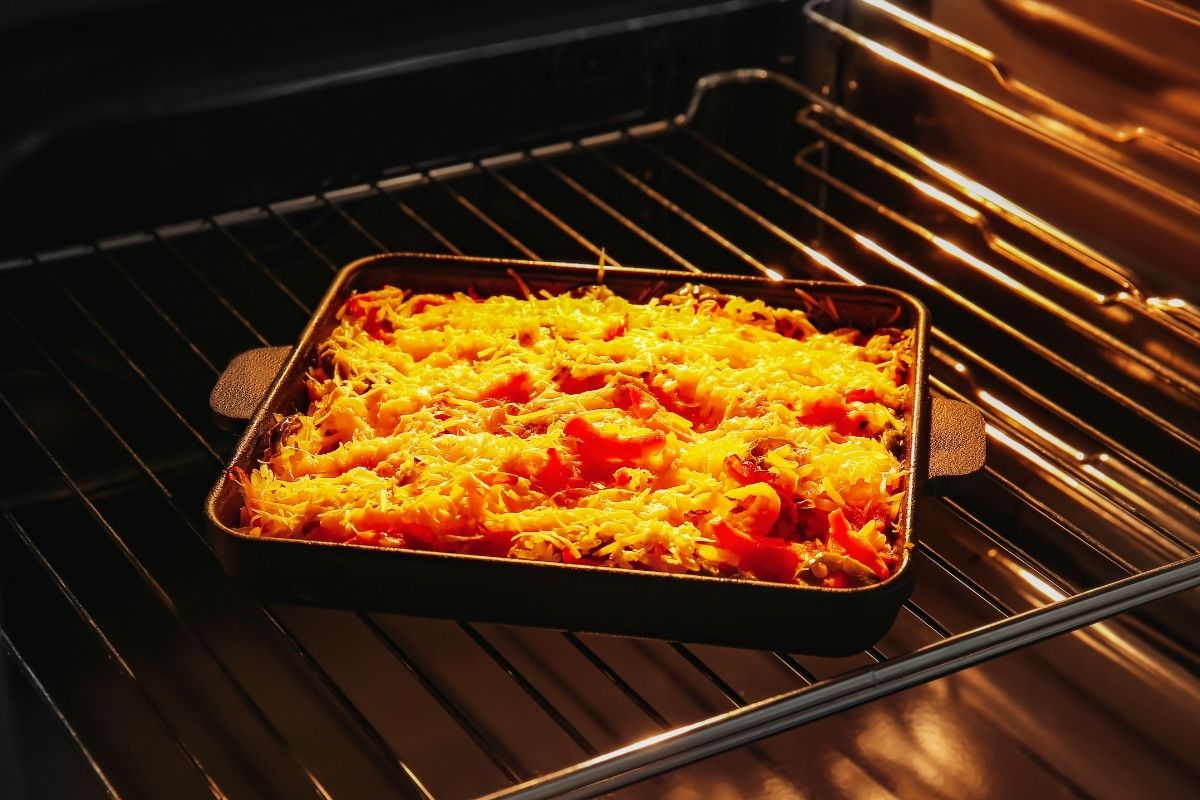3 Best Ways To Reheat Casserole (Updated 2025)

Learn how to reheat a casserole properly without making it dry or overcooked. There are different methods of reheating a casserole while keeping its original flavor.
Keep reading to learn the step-by-step instructions, as well as some tips and reminders.
A casserole is a versatile dish with many recipe versions. Commonly, it is a filling meal that includes meat, veggies, cheese, and sauces.
How To Reheat Casserole
1. Reheat Casserole Using Oven
Reheating in the oven is simple and effective. A casserole will become evenly heated in the oven. You will not have to worry about it getting dry or the edges being burned.
-
Allow the casserole to sit at room temperature for a bit. If time permits, remove it from the fridge for 20 minutes to soften it before reheating it.
-
Preheat the oven to 350 degrees Fahrenheit.
-
If the casserole is large, or it is thick, divide the dish into 2 or 4 parts depending on the size. The core will heat better and more evenly as a result.
-
Place the casserole on a baking tray. Then, cover it with aluminum foil. The foil is necessary not only to retain the juiciness of the dish but also to prevent the casserole’s edges from burning.
-
Heat the dish for around 20 minutes. Adjust the baking time based on the thickness of the casserole. For example, reduce the heating time to 15 minutes if you have small or thin portions.
-
Once ready, remove the casserole from the oven. Set it aside to cool for 2 to 3 minutes.
-
Serve and enjoy.
2. Reheat Casserole Using Stovetop
Reheating the casserole using a skillet or a pan on the stovetop is another great method. You need to monitor the heating process the whole time for the best results.
- Add a small amount of water or oil to the pan.
-
Heat the pan on the stovetop over medium heat until it starts boiling.
-
Put the casserole in the pan and cover it with the lid. The lid combined with the water or oil will keep the dish’s moisture. You can also opt to move the dish around.
-
Keep stirring the dish until warm enough.
-
Serve and enjoy.
3. Reheat Casserole Using Microwave
Reheating a casserole using the microwave is fast and easy. It is a decent method when you only have small portions. Your warmed dish will be ready in just a few minutes. Follow the instructions below to get the best results.
-
Break the casserole into smaller pieces. Usually, the exterior heats quickly, leaving the core of the casserole cold.
-
Put the dish in a microwave-safe container. Spread the casserole to make sure it heats evenly.
-
Make sure to cover the microwave-safe container but do not seal it completely, allowing steam to escape while reheating.
-
Heat the casserole for about 2 minutes in the microwave. The casserole will take around 2 to 3 minutes to heat completely. To begin, heat for 1 minute using the preheating setting on the microwave.
-
Remove the casserole from the microwave and flip the pieces as required to ensure even heating. Heat it again for a minute more. Then, check if it is warm enough. If necessary, heat again for 30 seconds, then an extra 30 seconds.
-
Once ready, remove the casserole from the microwave.
-
Serve and enjoy.
Other Important Tips and Reminders
To make sure the heat is evenly distributed throughout the casserole during the reheating process, you may cut it into smaller sizes to let the heat reach the dish’s core. You may also transfer it to a larger, oven-safe container.
To guarantee that your casserole is safe to consume, ensure that it reaches a 165 degrees Fahrenheit internal temperature.
Remember to eat the casserole within 2 days of storing it in the fridge. If you leave it in the fridge any longer, the casserole will get spoiled.
If the casserole is frozen, do not put it back in the freezer after you have taken it out. It is preferable to eat the dish within the day it was defrosted. When thawing a frozen casserole, wait until all the ice has melted before reheating it.
That said, the dish will turn mushy if you leave it out to thaw for an excessive period. Alternatively, use the microwave’s defrost mode. Wrap the casserole first with wax paper, then put it inside the microwave.
In Conclusion
Now you know how to reheat a casserole properly. You can choose to use the oven, microwave, or stovetop.
Make sure to follow the steps above to achieve a delicious warm casserole, just like when first cooked.
PrintHow To Reheat a Frozen Casserole
Knowing how to reheat a frozen casserole is a skill set that all people should have. It can come in handy in a world where we are constantly on the go and don’t have time for everything.
To reheat a casserole, you will need to follow these simple instructions:
Ingredients
- Frozen casserole
- Baking Sheet
- Oven
Instructions
- Preheat oven to 350 degrees Fahrenheit
- Place the frozen casserole on a baking sheet.
- Place the baking sheet in an oven for about 45 minutes, or until heated through.
- Turn off the oven and leave the casserole in the hot oven for an additional 10 minutes to ensure it is completely heated through.
- Remove from oven and serve!
you may also like
well hello there!

Hi, I'm Linda thanks for stopping by! We're so happy you're here. If you're a foodie and love to cook from home - you're in the right place..
LEARN MORE
free newsletter
Join the mailing list and receive our free newsletter!
recent posts
let's be social
search site
Recipe Marker
Recipe Marker provides you with the best information about home cooking tips, recipes, ingredient substitutes and more. Check out our blog to see the latest articles.
Copyright © 2024 Recipemarker.com | All Rights Reserved | Privacy | Disclaimer | Contact












